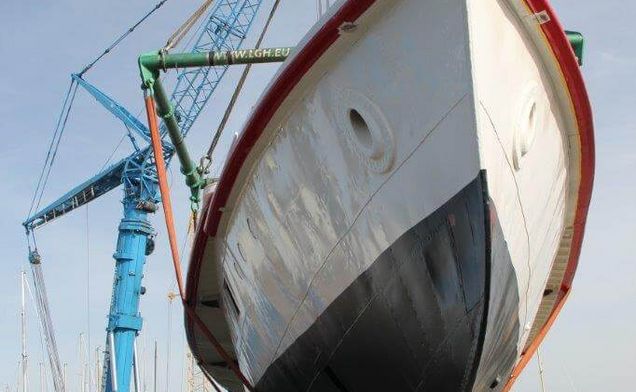Crane operation for historic barge
April 24, 2018 | Markus Lackner
For a long time, MS Österreich’s fate was in the air. The boat put into service in 1928 had been decommissioned in 2009. Due to high restoration costs, even scrapping it was an option at one time. But then, in 2015, Initiative zur Rettung der Österreich (“Initiative for the rescue of the vessel Österreich”) managed to acquire the boat. This led to the restoration of important parts of the boat in the following years.
Tandem lift to place boat on slipway
With a length of 55 metres, a width of ten and a height of eight, the former luxury boat taking people across Lake Constance weighed in at 160 tonnes. In order to lift the boat from the dry dock onto the slipway, two mobile cranes with maximum load capacities of 750 and 500 tonnes were used. “Transporting the two cranes required some 20 journeys,” Stütler explains the extent of the operation. The actual crane operation was preceded by a projecting phase lasting several months. “In its course, we coordinated dates, acquired permits for the crane transports, coordinated with the boat designers regarding possible installations that needed to be made before the lift, calculated lifting points on the boat as well as defined and manufactured suitable lifting equipment,” says Stütler, illustrating some of the details.
In mid-April the time had finally come to lift the boat from the dry dock onto the slipway. “At an outreach of 22 metres, we needed to lift a load of 160 tonnes which requires a hefty amount of power,” says Bau-Trans’ Project Manager in charge Jürgen Stütler, justifying the use of two large cranes. The hook block of the stronger truck crane (an LTM 1750) was connected to the boat’s bow while an LTM 1500 was used at the stern. Ballast weighing 204 and 165 tonnes, respectively, weighed the cranes down. The lifting operation itself was over in a mere two hours. Coordinating the two cranes was the hardest part. For in the course of the tandem lift, the water vessel had to be rotated by 90 degrees in the air to lift it between the two cranes and place it onto the slipway, Stütler reports. After that, it had to be rotated back to its original position to be able to lower it onto the slipway in parallel to the latter. Thanks to good preparations and the crane operators’ dexterity, everything worked smoothly, however.
Subsequent installation
In order to not unnecessarily increase the boat’s weight, several heavy parts such as generators, engines and the bow thruster were only installed after the lift operation was completed. This reduced the weight to be lifted by some 120 tonnes. The boat was then successfully launched in late April. Interior fit-out and installation work is to follow. By the end of the year, the Österreich is supposed to be launched on Lake Constance under the name MS Österreich.











